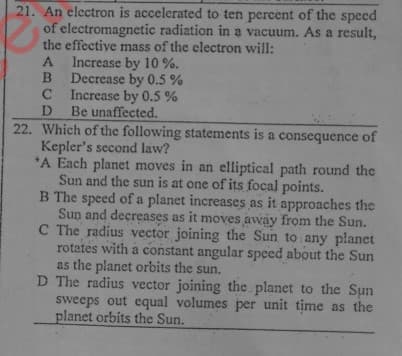21. An electron is accelerated to ten percent of the speed of electromagnetic radiation in a vacuum. As a result, the effective mass of the electron will: Increase by 10 %. Decrease by 0.5 % C Increase by 0.5 % D A Be unaffected. 22. Which of the following statements is a consequence of Kepler's second law? *A Each planet moves in an elliptical path round the Sun and the sun is at one of its focal points. B The speed of a planet increases as it approaches the Sun and decreases as it moves away from the Sun. C The radius vector joining the Sun to any planet rotates with a constant angular speed about the Sun as the planet orbits the sun. D The radius vector joining the planet to the Sun sweeps out equal volumes per unit time as the planet orbits the Sun.
21. An electron is accelerated to ten percent of the speed of electromagnetic radiation in a vacuum. As a result, the effective mass of the electron will: Increase by 10 %. Decrease by 0.5 % C Increase by 0.5 % D A Be unaffected. 22. Which of the following statements is a consequence of Kepler's second law? *A Each planet moves in an elliptical path round the Sun and the sun is at one of its focal points. B The speed of a planet increases as it approaches the Sun and decreases as it moves away from the Sun. C The radius vector joining the Sun to any planet rotates with a constant angular speed about the Sun as the planet orbits the sun. D The radius vector joining the planet to the Sun sweeps out equal volumes per unit time as the planet orbits the Sun.
College Physics
1st Edition
ISBN:9781938168000
Author:Paul Peter Urone, Roger Hinrichs
Publisher:Paul Peter Urone, Roger Hinrichs
Chapter33: Particle Physics
Section: Chapter Questions
Problem 8CQ: When a stat erupts in a supernova explosion, huge numbers of electron neutrinos are formed in...
Related questions
Question
Answer question 21, 22 showing fully all the steps. Solution should be simplified and easy to understand as much as possible!

Transcribed Image Text:21. An electron is accelerated to ten percent of the spced
of electromagnetic radiation in a vacuum. As a result,
the effective mass of the electron will:
A
Increase by 10 %.
B
Decrease by 0.5 %
C Increase by 0.5 %
D
Be unaffected.
22. Which of the following statements is a consequence of
Kepler's second law?
*A Each planet moves in an elliptical path round the
Sun and the sun is at one of its focal points.
B The speed of a planet increases as it approaches the
Sun and decreases as it moves away from the Sun.
C The radius vector joining the Sun to any planet
rotates with a constant angular speed about the Sun
as the planet orbits the sun.
D The radius vector joining the planet to the Sun
sweeps out equal volumes per unit time as the
planet orbits the Sun.
Expert Solution
This question has been solved!
Explore an expertly crafted, step-by-step solution for a thorough understanding of key concepts.
Step by step
Solved in 2 steps

Knowledge Booster
Learn more about
Need a deep-dive on the concept behind this application? Look no further. Learn more about this topic, physics and related others by exploring similar questions and additional content below.Recommended textbooks for you

College Physics
Physics
ISBN:
9781938168000
Author:
Paul Peter Urone, Roger Hinrichs
Publisher:
OpenStax College

Physics for Scientists and Engineers, Technology …
Physics
ISBN:
9781305116399
Author:
Raymond A. Serway, John W. Jewett
Publisher:
Cengage Learning

College Physics
Physics
ISBN:
9781305952300
Author:
Raymond A. Serway, Chris Vuille
Publisher:
Cengage Learning

College Physics
Physics
ISBN:
9781938168000
Author:
Paul Peter Urone, Roger Hinrichs
Publisher:
OpenStax College

Physics for Scientists and Engineers, Technology …
Physics
ISBN:
9781305116399
Author:
Raymond A. Serway, John W. Jewett
Publisher:
Cengage Learning

College Physics
Physics
ISBN:
9781305952300
Author:
Raymond A. Serway, Chris Vuille
Publisher:
Cengage Learning

Principles of Physics: A Calculus-Based Text
Physics
ISBN:
9781133104261
Author:
Raymond A. Serway, John W. Jewett
Publisher:
Cengage Learning

University Physics Volume 3
Physics
ISBN:
9781938168185
Author:
William Moebs, Jeff Sanny
Publisher:
OpenStax

Physics for Scientists and Engineers with Modern …
Physics
ISBN:
9781337553292
Author:
Raymond A. Serway, John W. Jewett
Publisher:
Cengage Learning